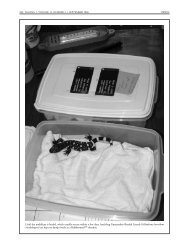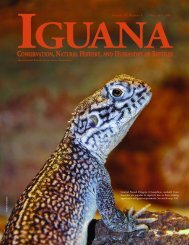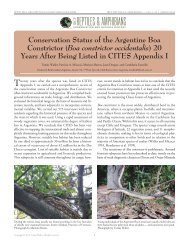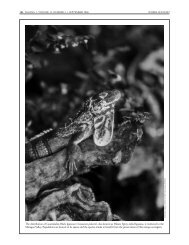Spiny-tailed Iguanas (Ctenosaura similis) in Venezuela
Spiny-tailed Iguanas (Ctenosaura similis) in Venezuela
Spiny-tailed Iguanas (Ctenosaura similis) in Venezuela
Create successful ePaper yourself
Turn your PDF publications into a flip-book with our unique Google optimized e-Paper software.
LAURIE J. VITT<br />
NATURAL HISTORY REPORTS<br />
Morphology and Diet of Two<br />
Sympatric Snakes<br />
PINTOETAL. (2008. Amphibia-Reptilia<br />
29:149–160) described the morphometry<br />
and diet of two sympatric species of<br />
Chironius (C. flavol<strong>in</strong>eatus and C. quadricar<strong>in</strong>atus)<br />
from Brazilian Cerrado. The<br />
two species differ <strong>in</strong> external morphology,<br />
with C. flavol<strong>in</strong>eatus longer and C.<br />
quadricar<strong>in</strong>atus heavier. Each species also<br />
showed marked sexual size dimorphism.<br />
Both species feed exclusively on frogs<br />
with a heavy preference for hylids, and<br />
may have a tendency to eat small prey.<br />
These two species have brownish ground<br />
colors and exhibit no ontogenetic variation,<br />
suggest<strong>in</strong>g that juveniles and adults<br />
use similar substrates. Chironius flavol<strong>in</strong>eatus<br />
and C. quadricar<strong>in</strong>atus are semiarboreal,<br />
forage actively, and usually feed<br />
on the ground. Chironius flavol<strong>in</strong>eatus<br />
uses higher vegetation for rest<strong>in</strong>g and,<br />
based on morphological results, seems to<br />
be more arboreal than C. quadricar<strong>in</strong>atus.<br />
Both Chironius flavol<strong>in</strong>eatus (top) and C.<br />
quadricar<strong>in</strong>atus (bottom) are semi-arboreal,<br />
forage actively, and usually feed on the<br />
ground, but the former is more slender and<br />
elongate, suggest<strong>in</strong>g that it is more arboreal.<br />
A unique life history among<br />
tetrapods: An annual chameleon<br />
liv<strong>in</strong>g mostly as an egg<br />
The ~28,300 species of tetrapods (fourlimbed<br />
vertebrates) almost exclusively<br />
have perennial life spans. KARSTEN ET AL.<br />
(2008. Proceed<strong>in</strong>gs of the National<br />
Academy of Sciences of the United States of<br />
America 105:8980–8984) discovered a<br />
remarkable annual tetrapod from the arid<br />
southwest of Madagascar: The chameleon<br />
Furcifer labordi, with a posthatch<strong>in</strong>g life<br />
span of just 4–5 months. At the start of<br />
the active season (November), an age<br />
cohort of hatchl<strong>in</strong>gs emerges; larger juveniles<br />
or adults are not present. These<br />
hatchl<strong>in</strong>gs grow rapidly, reach sexual<br />
maturity <strong>in</strong> less than 2 months, and<br />
reproduce <strong>in</strong> January–February. After<br />
reproduction, senescence appears, and<br />
the active season concludes with population-wide<br />
adult death. Consequently,<br />
dur<strong>in</strong>g the dry season, the entire popula-<br />
IGUANA • VOLUME 15, NUMBER 3 • SEPTEMBER 2008 179<br />
NATURAL HISTORY REPORTS<br />
CHRISTOPHER J. RAXWORTHY<br />
S. BLAIR HEDGES<br />
Furcifer labordi from Madagascar spends<br />
most of its life <strong>in</strong>side an egg.<br />
tion is represented by develop<strong>in</strong>g eggs<br />
that <strong>in</strong>cubate for 8–9 months before synchronously<br />
hatch<strong>in</strong>g at the onset of the<br />
follow<strong>in</strong>g ra<strong>in</strong>y season. Remarkably, this<br />
chameleon spends more of its short<br />
annual life cycle <strong>in</strong>side the egg than outside<br />
of it. A review of tetrapod longevity<br />
(>1,700 species) found no others with<br />
such a short life span. These f<strong>in</strong>d<strong>in</strong>gs suggest<br />
that the notorious rapid death of<br />
chameleons <strong>in</strong> captivity may, for some<br />
species, actually represent the natural<br />
adult life span. Consequently, a new<br />
appraisal may be warranted concern<strong>in</strong>g<br />
the viability of chameleon breed<strong>in</strong>g programs,<br />
which could have special significance<br />
for species of conservation concern.<br />
World’s Smallest Snake<br />
Islands are viewed as natural evolutionary<br />
laboratories for terrestrial organisms<br />
because they have boundaries that limit<br />
dispersal and often reveal evolutionary<br />
patterns and mechanisms. One such pattern<br />
is that the smallest and largest<br />
species of different types of tetrapod animals<br />
are frequently found on islands.<br />
HEDGES (2008. Zootaxa 1841: 1–30)<br />
described two new dim<strong>in</strong>utive species of<br />
The Barbados Threadsnake (Leptotyphlops carlae) may be the world’s smallest species of snake.








